From Potomac to Port du Punic
Brrrr . . . Washington D.C. in early March is not a pleasant area in which to spend one’s hard-earned free time. Winter persistently clings to the city long after its welcome has worn out and spring is more of a wishful thought than an actual season – if you blink, you’ll miss it. I wanted to escape the slushy streets, the threatening icicles, and the bone-chilling wind to spend my sabbatical from the law in a relaxed, sun-splashed country. Narrowing my choices was difficult, but I decided to trade the icy Potomac River for the warm Mediterranean Sea.

The flights were pretty uneventful, but I encountered a snag at Customs in Tunisia when one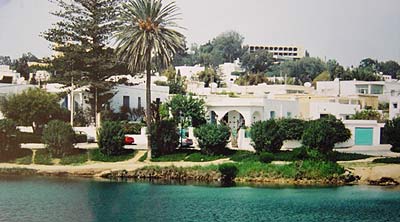 high-security-minded or too-much-free-time customs agent began questioning me about my itinerary, place of origin, parental lineage, and lack of passport stamps. He simply could not understand why I did not have an exit stamp from France even though I explained that I never left the Parisian airport and only landed there in transit to Tunisia. My lengthy, forthright answers dwindled away to one-word answers and shrugs until the agent finally let me through. The last one to clear Customs, I was also among the last ones to collect my luggage. Earlier, I witnessed an entire luggage cart tip over and fall off of a fast, weaving truck so that the entire metal cart flipped over and spilled its contents on the ground. I presume my luggage was on that cart because I had to wait for quite some time with a handful of other passengers before our few lowly belongings finally made their way to us on the creaky carousel.
high-security-minded or too-much-free-time customs agent began questioning me about my itinerary, place of origin, parental lineage, and lack of passport stamps. He simply could not understand why I did not have an exit stamp from France even though I explained that I never left the Parisian airport and only landed there in transit to Tunisia. My lengthy, forthright answers dwindled away to one-word answers and shrugs until the agent finally let me through. The last one to clear Customs, I was also among the last ones to collect my luggage. Earlier, I witnessed an entire luggage cart tip over and fall off of a fast, weaving truck so that the entire metal cart flipped over and spilled its contents on the ground. I presume my luggage was on that cart because I had to wait for quite some time with a handful of other passengers before our few lowly belongings finally made their way to us on the creaky carousel.
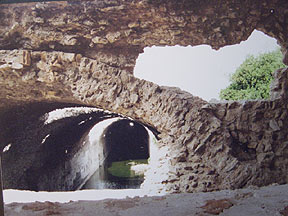 Lina welcomed me warmly at the airport’s lounge, whisked me away to Carthage, and brought me to her gorgeous house on the Port du Punic, the site of many a Roman vs. Carthaginian war but now the stomping grounds of history buffs, adventurous tourists, and government officials. Exhausted, hungry, and feeling a little ripe from all the travel, there was no rest for the weary as several of Lina’s friends, out for an evening stroll, stopped by for a visit. We chatted out on the front patio overlooking the warm, sparkling water of the Gulf of Tunis. Not wanting to offend the others, I sat downwind of them, sipped some refreshing mint tea, and snacked on almonds and raisins. After washing up, I had my first taste of Tunisia’s wonderful Harissa, a spicy chili paste that tastes heavenly when added to soup, meat, or fish. Lina had added it to the soup she had prepared for dinner and after one sip, I was hooked.
Lina welcomed me warmly at the airport’s lounge, whisked me away to Carthage, and brought me to her gorgeous house on the Port du Punic, the site of many a Roman vs. Carthaginian war but now the stomping grounds of history buffs, adventurous tourists, and government officials. Exhausted, hungry, and feeling a little ripe from all the travel, there was no rest for the weary as several of Lina’s friends, out for an evening stroll, stopped by for a visit. We chatted out on the front patio overlooking the warm, sparkling water of the Gulf of Tunis. Not wanting to offend the others, I sat downwind of them, sipped some refreshing mint tea, and snacked on almonds and raisins. After washing up, I had my first taste of Tunisia’s wonderful Harissa, a spicy chili paste that tastes heavenly when added to soup, meat, or fish. Lina had added it to the soup she had prepared for dinner and after one sip, I was hooked.
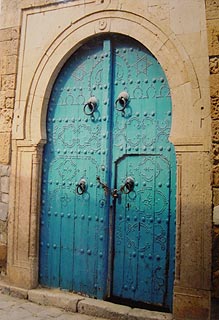
Day Two: After a breakfast of flaky chocolate croissants, hot coffee, and freshly squeezed blood-oranges from the market near Sidi Bou Said, Lina and I lazed around the front patio catching up on gossip, playing with Lina’s very mobile and inquisitive baby Hedi, and enjoying the view of the glittering, sapphire waters nearby. The perfect hostess, Lina had arranged for my first day in Tunisia to be a gentle, pampered one and so after lunch, she dropped me off for a two and a half hour full-body massage and facial at a nearby salon. I slaughtered the French language trying to converse with the woman giving me my massage and tried to stifle my laughter while getting my facial when I recognized the Muzak version of Bryan Adam’s classic, “Everything I Do, I Do It For You” playing overhead . . . twice. Since this was a day of relaxation, the remainder of the day was spent lounging about in Carthage and making plans for the rest of my visit.
Day Three: In the morning, I learned that some local police officers had stopped by the day before to question Lina’s maid about my “ultra-suspicious” visit to Tunisia. We brainstormed possible explanations for why my visit was arousing official attention. The customs agent must have alerted the local police about my presence because (a) the Carthaginian neighborhood is populated by some rather high-ranking government types that are defensive of their safety and privacy, (b) wedged between Algeria and Libya, war-free Tunisia is extremely wary and protective of its security, or (c) my sinister appearance and shifty eyes outweighed my normally “all access” US passport and raised all sorts of red flags and high alerts! The police officer had issued a pre-gubernatorial Arnold Schwarzenegger warning, “I’ll be back,” and left.
 We began our day by visiting several little clothing boutiques for some quick shopping. Only two hours away from Paris, Tunisia is a popular getaway for European travelers and offers great deals on haute-couture clothing, hand-painted pottery and ceramics, and exquisite carpets. After browsing, bargaining, and buying for a few hours, we took off to do some touristy stuff. First we frolicked with some baby goats at La Malga Cisterns. Fifteen huge cisterns, now either empty or filled with some nasty green sludge, a mattress and discarded aluminum cans, used to be filled by the Roman aqueduct with water from the town Zaghouan. Despite the generally polluted state of the cisterns, the place was made more attractive by the leaping baby goats. Next we stumbled upon some Roman ruins where an uninvited, rough-looking “guide” pointed out the columns, the mosaics, and the potential purposes for each piece of rubble before demanding some baksheesh (monetary gratification) for his troubles. We drove to the 13th century St. Louis Cathedral high on Byrsa Hill where we took in a spectacular view of the Mediterranean, Tunis, Carthage; we even managed to identify Lina’s house! We wandered around the museum and marveled at the ancient pieces, the incredibly well preserved mosaics, and complete lack of security to protect these priceless objets d’art. I was awed by how these prehistoric works of art could have survived so long. While admiring the simplicity and beauty of the glasswork and bowls, I was amazed at how easily I (or anyone else) could have stolen any of these relics. It was at once reassuring and inspiring.
We began our day by visiting several little clothing boutiques for some quick shopping. Only two hours away from Paris, Tunisia is a popular getaway for European travelers and offers great deals on haute-couture clothing, hand-painted pottery and ceramics, and exquisite carpets. After browsing, bargaining, and buying for a few hours, we took off to do some touristy stuff. First we frolicked with some baby goats at La Malga Cisterns. Fifteen huge cisterns, now either empty or filled with some nasty green sludge, a mattress and discarded aluminum cans, used to be filled by the Roman aqueduct with water from the town Zaghouan. Despite the generally polluted state of the cisterns, the place was made more attractive by the leaping baby goats. Next we stumbled upon some Roman ruins where an uninvited, rough-looking “guide” pointed out the columns, the mosaics, and the potential purposes for each piece of rubble before demanding some baksheesh (monetary gratification) for his troubles. We drove to the 13th century St. Louis Cathedral high on Byrsa Hill where we took in a spectacular view of the Mediterranean, Tunis, Carthage; we even managed to identify Lina’s house! We wandered around the museum and marveled at the ancient pieces, the incredibly well preserved mosaics, and complete lack of security to protect these priceless objets d’art. I was awed by how these prehistoric works of art could have survived so long. While admiring the simplicity and beauty of the glasswork and bowls, I was amazed at how easily I (or anyone else) could have stolen any of these relics. It was at once reassuring and inspiring.
 Day Four: Our day of exploring ancient Roman ruins began at a recently discovered archeological dig in Uthina. Lina’s mother-in-law Michelle is an adventurous teacher who, with her colleagues, found out about the dig eight years earlier and continued to visit it periodically. Michelle came by early in the morning to pick us up and graciously offered to take us to Uthina. We drove from Carthage across the causeway over Lake Tunis and threaded our way through the heart of Tunis until the crowded, bustling city gave way to lesser populated towns and greater expanses of cultivated land. Despite the current drought, there were a few stretches of green so vibrant that it hurt your eyes to look at it. We stopped along the route to Zaghouan to explore portions of what in the 2nd century A.D. used to be a 70 km-long Roman aqueduct that led to Carthage's La Malga Cisterns.
Day Four: Our day of exploring ancient Roman ruins began at a recently discovered archeological dig in Uthina. Lina’s mother-in-law Michelle is an adventurous teacher who, with her colleagues, found out about the dig eight years earlier and continued to visit it periodically. Michelle came by early in the morning to pick us up and graciously offered to take us to Uthina. We drove from Carthage across the causeway over Lake Tunis and threaded our way through the heart of Tunis until the crowded, bustling city gave way to lesser populated towns and greater expanses of cultivated land. Despite the current drought, there were a few stretches of green so vibrant that it hurt your eyes to look at it. We stopped along the route to Zaghouan to explore portions of what in the 2nd century A.D. used to be a 70 km-long Roman aqueduct that led to Carthage's La Malga Cisterns.
Thirty kilometers south of Tunis, we arrived in Uthina/Oudna, described by Pliny as one of the oldest towns in Africa, and the site of a major Roman/Carthaginian battle in 255 B.C. Despite its historical significance, Uthina is not well-known, even among the Tunisians. Incredibly enough, except for a handful of workers, we were the only three people in the entire area. Admission? One dollar. Snacks of water, granola bars, and chewing gum? Two dollars. Tourist-free exploration of an active archeological dig in the middle of nowhere, Tunisia? Priceless.
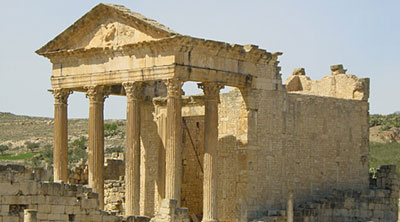 Michelle acted as our tour guide and led us to the capitol at the top of the hill. We walked down to the partially-excavated baths, climbed up and down the somewhat-treacherous remains of the villas, and viewed the amazing mosaic floors, parts of which have been removed and are now on display at the Bardo Museum in Tunis. Although they were completely exposed to the elements, the mosaics were so well preserved that they almost looked new. Michelle explained that the Romans used the decorative mosaics in the same manner that we would use wallpaper: when a design no longer suited them, they would simply retile over the old mosaic. Sure enough, where there was a break in a section of the mosaic, I could see distinct pattern underneath. We proceeded into the enormous amphitheater/coliseum, sat down on one of the top tiers, and imagined what it must have been like to sit there amidst an audience of 10,000 for a night of tragedy or comedy. Unfortunately, the only performance we witnessed was a gathering of workers drinking tea and lounging around on their lunch break while they, in turn, watched us.
Michelle acted as our tour guide and led us to the capitol at the top of the hill. We walked down to the partially-excavated baths, climbed up and down the somewhat-treacherous remains of the villas, and viewed the amazing mosaic floors, parts of which have been removed and are now on display at the Bardo Museum in Tunis. Although they were completely exposed to the elements, the mosaics were so well preserved that they almost looked new. Michelle explained that the Romans used the decorative mosaics in the same manner that we would use wallpaper: when a design no longer suited them, they would simply retile over the old mosaic. Sure enough, where there was a break in a section of the mosaic, I could see distinct pattern underneath. We proceeded into the enormous amphitheater/coliseum, sat down on one of the top tiers, and imagined what it must have been like to sit there amidst an audience of 10,000 for a night of tragedy or comedy. Unfortunately, the only performance we witnessed was a gathering of workers drinking tea and lounging around on their lunch break while they, in turn, watched us.
We resumed climbing, ducking, leaping, and general tramping about, awed and exhilarated by the fact that these ancient ruins were still in the process of being discovered and we had the entire place to ourselves. We could touch whatever we wanted to, stand in silence among the ruins when it suited us, and snap as many photographs as we chose, blatantly disregarding the clearly marked signs prohibiting it.
Day Five: Early in the morning, Lina and I decided to visit the Bardo Museum in Tunis. Originally constructed as a palace in the 1200s, in 1888 the Bardo Museum began exhibiting items from ancient sites throughout Tunisia. We started the trek through the three-storied museum with a collection of skulls and stones from 200,000 B.C. After the first 100,000 years back, who really keeps counting? The sheer age of some of these exhibits made us cynical and snooty towards the newer exhibits. “Only 5th century? And A.D. at that?” We turned up our noses and sniffed in derision, “Next!” We saw funeral masks, sarcophagi, and some creepy, dancing dwarf figurines that are sure to play a role in an up-coming nightmare! Entire walls were covered in tapestries and mosaics. A few rooms were crammed full of Roman statues of various deities. Most impressive was the museum's gift shop which sold books on all things Tunisian, including Thomas Harris' bestseller "Hannibal" - the sequel to "Silence of the Lambs". Now, I knew that Hannibal Barca, the great Carthaginian general who almost completely defeated the Roman Empire, was from Tunisia, but before my trip to the Bardo, I had no idea that Dr. Hannibal Lecter was Tunisian as well.
Day Six: True to his word, Schwarzenegger returned while we were eating breakfast. He proceeded to question Lina about her background (American-Tunisian-Palestinian born in Switzerland), her language skills (English, French, and Tunisian Arabic), me (American-Pakistani born in Wales), my purpose for visiting (escape from winter), and various other topics until he was satisfied that we were not immediate threats to the security of the neighborhood or the nation. We spent the rest of the morning puttering around and packing for our weekend getaway. Then we headed off to Hammamet on the Cap Bon Peninsula.
We resumed climbing, ducking, leaping, and general tramping about, awed and exhilarated by the fact that
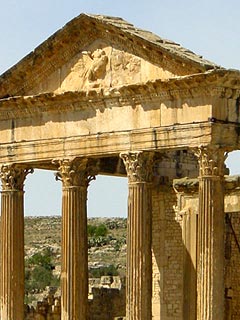
these ancient ruins were still in the process of being discovered and we had the entire place to ourselves. We could touch whatever we wanted to, stand in silence among the ruins when it suited us, and snap as many photographs as we chose, blatantly disregarding the clearly marked signs prohibiting it.
Day Five: Early in the morning, Lina and I decided to visit the Bardo Museum in Tunis. Originally constructed as a palace in the 1200s, in 1888 the Bardo Museum began exhibiting items from ancient sites throughout Tunisia. We started the trek through the three-storied museum with a collection of skulls and stones from 200,000 B.C. After the first 100,000 years back, who really keeps counting? The sheer age of some of these exhibits made us cynical and snooty towards the newer exhibits. “Only 5th century? And A.D. at that?” We turned up our noses and sniffed in derision, “Next!” We saw funeral masks, sarcophagi, and some creepy, dancing dwarf figurines that are sure to play a role in an up-coming nightmare! Entire walls were covered in tapestries and mosaics. A few rooms were crammed full of Roman statues of various deities. Most impressive was the museum's gift shop which sold books on all things Tunisian, including Thomas Harris' bestseller "Hannibal" - the sequel to "Silence of the Lambs". Now, I knew that Hannibal Barca, the great Carthaginian general who almost completely defeated the Roman Empire, was from Tunisia, but before my trip to the Bardo, I had no idea that Dr. Hannibal Lecter was Tunisian as well.
Day Six: True to his word, Schwarzenegger returned while we were eating breakfast. He proceeded to question Lina about her background (American-Tunisian-Palestinian born in Switzerland), her language skills (English, French, and Tunisian Arabic), me (American-Pakistani born in Wales), my purpose for visiting (escape from winter), and various other topics until he was satisfied that we were not immediate threats to the security of the neighborhood or the nation. We spent the rest of the morning puttering around and packing for our weekend getaway. Then we headed off to Hammamet on the Cap Bon Peninsula.
An hour's drive later, we checked into the Hotel Hasdrubal Thalassa, listed as one of the Leading Hotels of
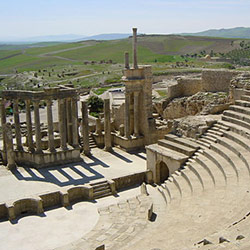
the World and awarded the Guinness World Record for the largest hotel presidential suite. The hotel is world-renowned for its Thalasso Spa, but since this was the depth of tourist season (peak season is July through August), there were only a few other guests that we saw floating around in white terry-cloth robes. After a quick lunch in the deserted courtyard and some channel surfing in the rooms, we elected to warm the chill out of our bones by hiking all over the maze-like hotel until we found the gym and the sauna. While Lina struggled to find a piece of exercise equipment that worked, I checked out the empty hammam (bathhouse) and then sat in the sauna with the mantra, "Man, it's like a sauna in here," going through my head as sweat poured out of me. Completely dehydrated after about twenty minutes, I quit the sauna less from boredom or water deficit than because they turned the lights out on me.
Lina’s husband Slim, who was in Congo for a business trip, had arrived back in Tunisia and drove straight from the airport to the hotel to meet us for dinner. We regaled Slim with stories of our adventurous activities at the archeological dig and he countered with his too vivid description of his sketchy accommodations in the Congo. After a wonderful meal in the near-empty hotel restaurant, we ensconced ourselves in our luxurious rooms and fell asleep immediately.
Day Seven: I rose very early in the morning and kept the sun company as it made its rapid ascent over the “wine dark” Mediterranean Sea. After a quick rinse in the hotel’s saltwater shower and a brief stroll on the empty beach, I met Lina, Slim, and Hedi for breakfast of pastries, coffee, and a variety of dairy products. Slim and I had a pleasant drive back to the airport in Tunis to retrieve my sister Naseem who arrived on time, with no customs hassles, and with no trouble collecting her luggage. As we whizzed by the olive and almond trees, I brought Naseem up to speed on all of the things she missed (the facial, the trip to Uthina, the museum) and she brought me up to speed on all of the things I missed (gossip from work and the latest Buffy episodes).
Our next stop was the very exclusive, world-renowned Yasmine Golf Course. At the clubhouse, we met with some of Lina’s and Slim’s friends who were visiting Hammamet for a weekend getaway. They had arranged for a private golf lesson for everyone and so after some tea at the clubhouse, we went out to the driving range. The instructor began the lesson in French until one helpful person pointed out that he should insert a little English now and then for my benefit. Apparently, I understood enough of his instructions and remembered enough of my father’s advice over the years because as we all took our practice shots, the instructor watched me, singled me out, and called all twelve friends over to watch me swing. So while they all created a half-circle behind me, collective arms folded, every pair of eyes watching every move I made, I managed to get off a solid, straight hit. My mind cleared, my body sagged in relief, and I stepped away, completely prepared to lose myself in the crowd and let someone else take the limelight. “Again!” they cried in unison. Peer pressure had me back at the tee, concentrating intensely, and thinking, “Be the ball.” Another hit, direct and true. I bowed to their applause and slunk away before my luck ran out.
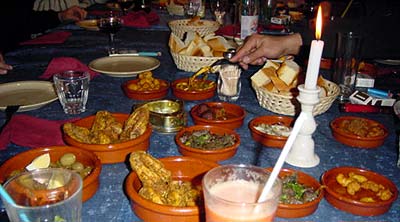 Later that night, we dined at a very popular tapas restaurant and night club called Buena Vista Social Club (I never quite figured it out). Our group had now expanded to twenty to include the wives, husbands, and children of our fellow golfers. We shared tapas, discoed to club music, and threw rose and jasmine petals at each other until 2 a.m. (The only thing more surprising than the fact that Microsoft Word actually recognized “discoed” as a word in the preceding sentence is that I actually discoed.) Some of the friends who earlier that day swung their clubs on the golf course succumbed to the music and swung their hips on the dining table. By the time we left, the place was packed and there was a line of people outside trying desperately to get past the bouncer and join the party. Upon returning to the hotel, I took another salty shower and tried to get as much smoke out of my hair, skin, and throat as I could before retiring.
Later that night, we dined at a very popular tapas restaurant and night club called Buena Vista Social Club (I never quite figured it out). Our group had now expanded to twenty to include the wives, husbands, and children of our fellow golfers. We shared tapas, discoed to club music, and threw rose and jasmine petals at each other until 2 a.m. (The only thing more surprising than the fact that Microsoft Word actually recognized “discoed” as a word in the preceding sentence is that I actually discoed.) Some of the friends who earlier that day swung their clubs on the golf course succumbed to the music and swung their hips on the dining table. By the time we left, the place was packed and there was a line of people outside trying desperately to get past the bouncer and join the party. Upon returning to the hotel, I took another salty shower and tried to get as much smoke out of my hair, skin, and throat as I could before retiring.
Day Eight: The Hotel Hasdrubal Thalassa offered a variety of body treatments from the simple saltwater hydrotherapy and seaweed wraps to the rather worrisome “lymphatic drainage”. My sister and I opted for simple massages and, while I found mine to be vigorous yet relaxing, it sounded like she was getting the WWF Smackdown version. We followed the massages up with a trip to the hammam and then took a stroll on the pristine, golden beach where, despite the fact that our bodies were overheated from the sauna, we could not bring ourselves to dip more than our toes into the cool sea let alone our entire bodies. We finally understood why everyone was laughing at us the night before when my sister confidently stated that she was going to swim in the Mediterranean no matter how cold the locals claimed it was. More knowledgeable now, even we shook our heads and made fun of the person we saw water-skiing.
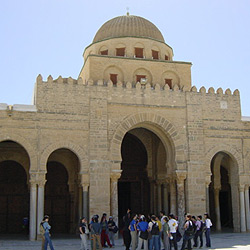 We spent the afternoon driving north along the Cap Bon’s coast where we saw flocks of pink flamingos flying overhead and cows serenely grazing near the sea. We marveled at Slim’s ability to maneuver the car through the extremely narrow alleyways in Nabeul and speed through Korba and all of its litter. When we arrived Kelibia, it began to drizzle and so we made ourselves comfortable at the Restaurant el-Mansourah which commands magnificent views of an impressive 6th century Byzantine fort high up on the hill as well as Mansourah Beach and the choppy sea right next to us. On a clear day, Sicily is visible from the beach, but it was cloudy and rainy, so we focused our eyes on the meal presented to us: traditional Tunisian briq a l’oeuf (a deep-fried egg encased in a flaky, pastry envelope and served with a slice of lemon) and briq au thon (ditto, but with tuna). Sticky, messy, greasy thumbs up all around. We finished up our warm bread, olives, harissa, and rouget fish (red mullet) and headed outside where we stood on the deck for a moment to watch the sea churn away and get darker and wilder by the minute. The rain was cold and started to sting, so we bundled into the car and voted to forgo the rest of the drive north to Kerkouane. Instead we headed home to the promise of hot pizza, fresh bathing water, and cozy pajamas.
We spent the afternoon driving north along the Cap Bon’s coast where we saw flocks of pink flamingos flying overhead and cows serenely grazing near the sea. We marveled at Slim’s ability to maneuver the car through the extremely narrow alleyways in Nabeul and speed through Korba and all of its litter. When we arrived Kelibia, it began to drizzle and so we made ourselves comfortable at the Restaurant el-Mansourah which commands magnificent views of an impressive 6th century Byzantine fort high up on the hill as well as Mansourah Beach and the choppy sea right next to us. On a clear day, Sicily is visible from the beach, but it was cloudy and rainy, so we focused our eyes on the meal presented to us: traditional Tunisian briq a l’oeuf (a deep-fried egg encased in a flaky, pastry envelope and served with a slice of lemon) and briq au thon (ditto, but with tuna). Sticky, messy, greasy thumbs up all around. We finished up our warm bread, olives, harissa, and rouget fish (red mullet) and headed outside where we stood on the deck for a moment to watch the sea churn away and get darker and wilder by the minute. The rain was cold and started to sting, so we bundled into the car and voted to forgo the rest of the drive north to Kerkouane. Instead we headed home to the promise of hot pizza, fresh bathing water, and cozy pajamas.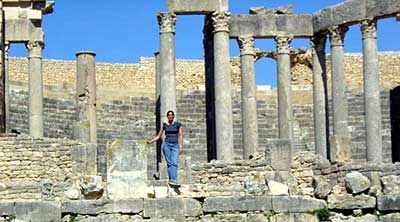
Day Nine: We spent the morning in Sidi Bou Said climbing up the steep cobbled streets, admiring the beautiful blue doorways, and sipping mint tea with pine nuts at the top of the cliff overlooking Carthage and the Gulf of Tunis. The sun was out and the breeze was just gentle enough to lull us into becoming complete slugs. After soaking up the rays and the view, we finally hauled ourselves up and meandered down the hill. We did some window-shopping at the souvenir stalls, antique stores, and art shops. Naseem and I had some henna tattoos painted on our arms by a local artist, but the design faded away by the end of the day. After an enjoyable lunch of some traditional Tunisian couscous, we strolled around the neighborhood. A friend of Lina’s invited us to visit her home in La Marsa, a beachside suburb nearby, and we spent the remainder of the day lounging around eating sweets made out of pistachios and dates and drinking more tea. We returned to Carthage that evening and filled our bellies with harissa soup for dinner and Belgian chocolates for dessert. We ended the day with half a game of French Monopoly before drowsiness overtook us and directed us directly to bed. Do not pass Départ. Do not collect 20,000 francs.
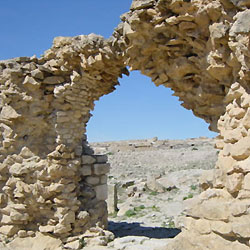
Day Ten: Early in the morning, we drove two hours west of Tunis up into the Tebersouk Mountains to the ancient Roman city of Dougga. We entered the site from what we later learned was the back (and therefore free) entrance. Dougga was almost as isolated as Uthina; there were only a few tourists and shepherds scattered around. We began with the 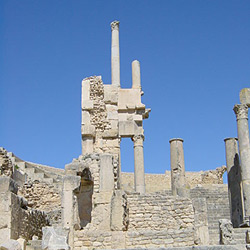 2nd century old Theater and, perched on the top tiers, savored an excellent view of the valley below. Next stops: the Temple of Saturn that overlooked the village; the Cisterns, the Baths and the Latrines that were all baking in the blazing sun along with us; and finally, the Capitol that lorded over the other twenty-odd temples. We climbed up the side of the mountain to ditch a would-be tour guide then descended narrow, stone steps into a deserted, chilly tunnel which ran beneath the ruins. The mosaics that the Bardo Musuem hadn't already pilfered were quite impressive, as were the soaring columns, the crumbling arches, and the teeny mosque that stood next to what used to be the Temple of Venus. After the full day of our self-guided tour, we dined at Les Ombrelle which was right on the water in La Marsa and provided a lovely view of evening settling on the water and the land.
2nd century old Theater and, perched on the top tiers, savored an excellent view of the valley below. Next stops: the Temple of Saturn that overlooked the village; the Cisterns, the Baths and the Latrines that were all baking in the blazing sun along with us; and finally, the Capitol that lorded over the other twenty-odd temples. We climbed up the side of the mountain to ditch a would-be tour guide then descended narrow, stone steps into a deserted, chilly tunnel which ran beneath the ruins. The mosaics that the Bardo Musuem hadn't already pilfered were quite impressive, as were the soaring columns, the crumbling arches, and the teeny mosque that stood next to what used to be the Temple of Venus. After the full day of our self-guided tour, we dined at Les Ombrelle which was right on the water in La Marsa and provided a lovely view of evening settling on the water and the land.
 Day Eleven: This morning, we went to the Convention Center that was hosting an arts and crafts fair for local women in honor of International Women’s Day. Colorful kilims, olive wood carvings, and antique shawls were on display throughout the hall along with gargantuan posters of the ever-present, but rarely-talked-about, president. With friendly smiles and gentle negotiations, a number of the sellers cut us some deals on the wares we bought and threw in some extra gifts. We continued our day of shopping at Lake Tunis where we found European fashion and goods at reasonable Mediterranean prices. We finished up the day with dinner at a posh restaurant/rotary club called Le Cloisters which is the place to see and be seen. Jasmine and freesia flowers were offered to all of the ladies, the waiters were attentive and courteous, and each dish was superb.
Day Eleven: This morning, we went to the Convention Center that was hosting an arts and crafts fair for local women in honor of International Women’s Day. Colorful kilims, olive wood carvings, and antique shawls were on display throughout the hall along with gargantuan posters of the ever-present, but rarely-talked-about, president. With friendly smiles and gentle negotiations, a number of the sellers cut us some deals on the wares we bought and threw in some extra gifts. We continued our day of shopping at Lake Tunis where we found European fashion and goods at reasonable Mediterranean prices. We finished up the day with dinner at a posh restaurant/rotary club called Le Cloisters which is the place to see and be seen. Jasmine and freesia flowers were offered to all of the ladies, the waiters were attentive and courteous, and each dish was superb.
Day Twelve: We drove from Tunis on a road with brilliant, green grass on one side and arid, desert on the other. One sign we passed indicated that Algeria lay in one direction and Libya lay in the other direction; we just kept heading directly south. Two hours later, we arrived at Sidi Okba Mosque (a.k.a. “the Great Mosque”) in Kairouan, Tunisia’s holy city. Although the exterior looks more like a severe fort than a lavishly designed mosque, the interior is amazing: a vast marble-paved courtyard, towering Roman and Byzantine columns, and delicate 9th century tiles and gorgeous carpets. Several marble wells had deep grooves on the lips created by centuries of rope friction as water was hauled up from the cisterns below. After appreciating the Great Mosque’s splendor, we set out to purchase kilims. The protocol required us to take our time, chat a bit with the seller, choose the kilims we wished to purchase, negotiate the price over some coffee and tea, and then close the deal. Bargaining complete, we headed back to Carthage, observing how the landscape changed from dusty desert to lush green the further north we traveled.
Byzantine columns, and delicate 9th century tiles and gorgeous carpets. Several marble wells had deep grooves on the lips created by centuries of rope friction as water was hauled up from the cisterns below. After appreciating the Great Mosque’s splendor, we set out to purchase kilims. The protocol required us to take our time, chat a bit with the seller, choose the kilims we wished to purchase, negotiate the price over some coffee and tea, and then close the deal. Bargaining complete, we headed back to Carthage, observing how the landscape changed from dusty desert to lush green the further north we traveled.
For our last night in Tunisia, we treated ourselves to a meal at El Dar which is a one-time mansion converted into über-fancy restaurant in downtown Tunis. The high ceilings and spacious, antique-filled rooms were elegantly decorated and the classic Tunisian fare was exquisite. We were provided with little silver dishes filled with water and lemon to cleanse our fingertips after we enjoyed our briq a l’oeuf. We stuffed ourselves on the precisely prepared couscous with lamb. And then, just to make that last button pop, we had hazelnut ice cream for dessert.
Alas, before we knew it, it was time to bid our hosts adieu and return home. We did not get to enjoy all of the wonders Tunisia had to offer such as seeing the magnificent Coliseum in El-Jem, exploring the great Sahara desert on camel-back, or getting in touch with our inner nerds by visiting the Star Wars space bar at Hotel Sidi Driss in Matmata. Then again, that just gave us an excuse to plan another visit to this marvelous, exotic country.
